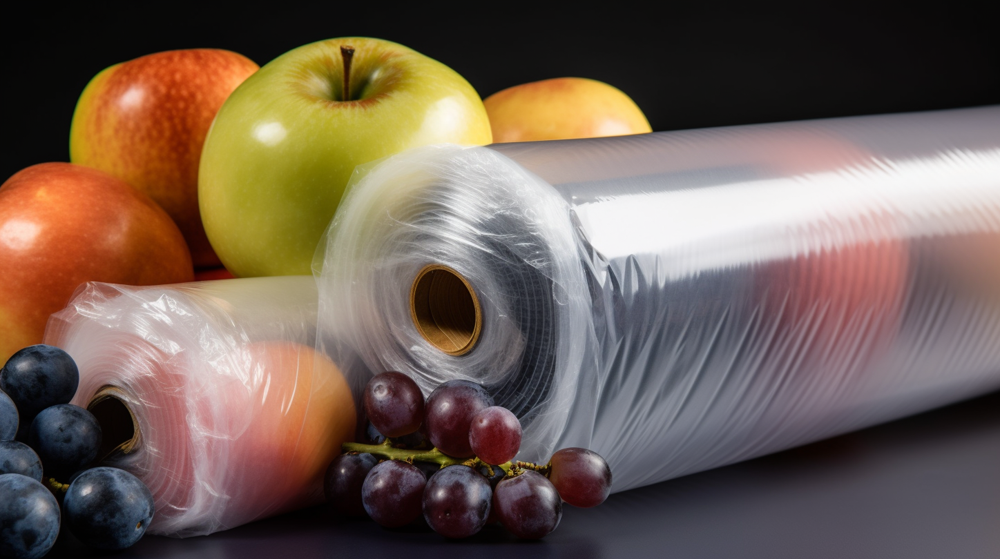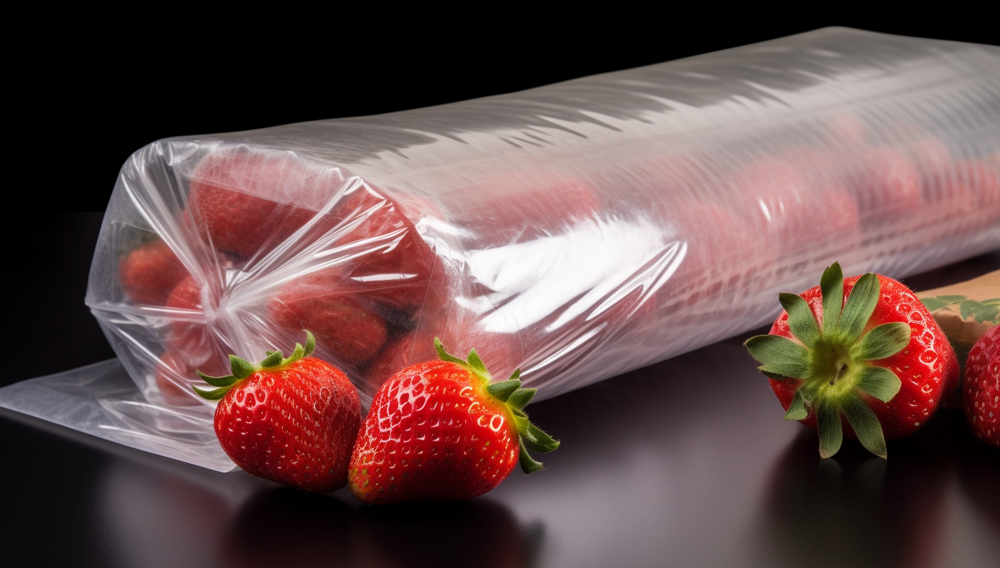When it comes to transporting perishable products, choosing the right packaging is crucial to maintain their quality and freshness. One popular option is ventilated stretch film, which allows air to circulate while also keeping the products securely wrapped. But with so many options available, how do you select the best film for your needs?
You need to ensure the film has the right level of permeability to allow air to flow through while still providing sufficient protection. Additionally, you should look at the thickness and strength of the film to ensure it can withstand the rigors of transportation and handling.
Learn about the key factors to consider when selecting the right ventilated stretch film, including permeability, thickness, and strength. Find out how using the right film can prevent spoilage and reduce waste, saving you time and money in the long run.
1. Introduction

A. Definition of ventilated stretch film
Ventilated stretch film is a type of packaging material used for wrapping and securing perishable products during transportation and storage. It is designed with small holes or perforations to allow air to circulate, which helps to prevent the buildup of moisture and humidity that can cause spoilage.
B. Importance of ventilated stretch film for perishable products
Ventilated stretch film is crucial for perishable products because it helps to maintain their freshness and extend their shelf life. The ventilated stretch film allows air to flow through the packaging while still providing a tight and secure wrap, which helps to prevent the growth of bacteria and mold. It is a cost-effective and eco-friendly alternative to other packaging materials that may be more harmful to the environment.
2. Characteristics of Perishable Products
A. Definition of perishable products
Perishable products are goods or items that have a limited lifespan and are susceptible to deterioration or decay over time. These products are typically fresh or semi-perishable, such as fruits, vegetables, meat, dairy products, baked goods, and flowers.
B. Challenges of handling perishable products
Some of the main challenges of handling perishable products include:
- Many perishable products require specific temperature conditions to maintain their quality and prevent spoilage. Failure to maintain proper temperature control during transportation and storage can result in spoilage and waste.
- Perishable products can be sensitive to humidity, which can cause them to wilt, mold, or rot. Proper humidity control is important to ensure that these products stay fresh and maintain their appearance.
- Perishable products have a limited lifespan and need to be transported and sold quickly to avoid spoilage. This can create time constraints for handling and transportation that require careful planning and coordination.
- Perishable products can be delicate and prone to damage during handling and transportation. Careful handling and packaging are essential to ensure that these products remain intact and marketable.
- Many perishable products are subject to regulations related to health and safety, such as food safety regulations. Compliance with these regulations can add additional complexity and challenges to handling and transporting these products.
C. Importance of ventilation for perishable products
Ventilation is important for perishable products because it helps to regulate temperature and humidity, which are critical factors in maintaining the quality and freshness of these products. Proper ventilation allows air to circulate the products, which helps to prevent the buildup of moisture and heat that can lead to spoilage and deterioration.
3. Ventilated Stretch Film
A. Understand the characteristic of ventilated stretch film
Ventilated stretch film is a specialized type of stretch film that is designed with micro-perforations or ventilation holes to allow for air circulation and moisture control. Ventilated stretch film is typically made from a high-quality resin material that is durable and puncture-resistant, but still allows for breathability. It can maintain a consistent temperature and humidity level and provides protection against dust, dirt, and debris, while still allowing for easy identification and scanning of the product.
B. Types of ventilated stretch film
There are several types of ventilated stretch film available for use with perishable products, including:
- Micro-perforated stretch film: This type of stretch film has small, evenly spaced holes or perforations that allow air to circulate the products. It is suitable for products that require moderate ventilation.
- Macro-perforated stretch film: This stretch film has larger, more widely spaced perforations that allow for greater airflow. It is suitable for products that require more significant ventilation.
- Hybrid stretch film: This type of stretch film combines both micro-perforations and macro-perforations to provide a balance of ventilation and protection. It is suitable for products that require both protection and ventilation.
- Breathable stretch film: This stretch film is designed to allow air and moisture to pass through the film, while still protecting against contamination and damage. It is suitable for products that require high levels of ventilation and protection.
C. Advantages of using ventilated stretch film for perishable products
Using ventilated stretch film for perishable products offers several advantages, including:
- Improved shelf life: Ventilated stretch film allows for proper airflow around the product, which helps to maintain the optimal temperature and humidity conditions required to preserve the freshness and quality of perishable products. This can extend the shelf life of these products and reduce the risk of spoilage and waste.
- Reduced condensation: By allowing air to circulate the product, the ventilated stretch film can help to reduce condensation, which can lead to mold growth and other forms of spoilage.
- Cost-effective: The ventilated stretch film is a cost-effective solution for protecting perishable products during transportation and storage. It can help to reduce the risk of damage and spoilage, which can result in significant cost savings.
- Versatile: The ventilated stretch film is available in different types and styles to meet the specific needs of different products. This makes it a versatile solution for a wide range of perishable products, including fruits, vegetables, meats, and dairy products.
- Environmentally friendly: The ventilated stretch film is typically made from recyclable materials, which makes it an environmentally friendly option for businesses looking to reduce their environmental footprint.
4. Applications of Ventilated Stretch Film for Perishable Products

A. Food industry
Ventilated stretch film is widely used in the food industry for a variety of perishable products, including:
- Fresh produce: The ventilated stretch film is commonly used to protect fruits and vegetables during transportation and storage. Proper ventilation helps to maintain the freshness and quality of these products, which is essential for ensuring customer satisfaction.
- Meat and poultry: Ventilated stretch film is used to protect meat and poultry products from contamination and spoilage during transportation and storage. Proper ventilation helps to regulate the temperature and humidity levels required to maintain the quality and freshness of these products.
- Dairy products: The ventilated stretch film is used to protect dairy products such as cheese and yogurt from spoilage and damage during transportation and storage. Proper ventilation helps to maintain the appropriate temperature and humidity conditions required to preserve the quality of these products.
- Seafood: Ventilated stretch film is used to protect seafood products such as fish and shellfish from contamination and spoilage during transportation and storage.
B. Agricultural industry
Ventilated stretch film is also widely used in the agricultural industry for a variety of perishable products, including horticultural products such as flowers, plants, and bulbs during transportation and storage. Ventilated stretch film is used to protect agricultural products such as grains, fruits, and vegetables during transportation and storage.
Ventilated stretch film is used to protect livestock such as poultry and swine during transportation. The film is also used to protect hay and straw during transportation and storage.
C. Pharmaceutical industry
Ventilated stretch film is also used in the pharmaceutical industry for the protection and transportation of perishable products such as vaccines, medicines, and diagnostic kits. The use of ventilated stretch film in this industry is essential because many pharmaceutical products are sensitive to temperature, humidity, and light.
5. Best Practices for Using Ventilated Stretch Film
A. Proper handling and storage
Here are some tips for handling and storing ventilated stretch film:
- Ventilated stretch film should be stored in a cool, dry place away from direct sunlight and heat sources. Exposure to heat and sunlight can cause the film to degrade and lose its effectiveness.
- When handling ventilated stretch film, it is important to handle it with care to prevent tears and punctures that can compromise its protective properties. Use proper lifting and handling techniques and avoid dragging the film across rough surfaces.
- Use appropriate equipment such as a stretch film dispenser to apply the ventilated stretch film to the products. This helps to ensure that the film is applied evenly and securely, providing maximum protection to the products.
- Before using ventilated stretch film, check for damages such as tears, punctures, or other signs of wear and tear. The damaged film should be discarded and replaced with a new film to ensure maximum protection for the products.
- Follow the manufacturer’s instructions for the proper application and use of ventilated stretch film. This includes using the appropriate amount of film, ensuring proper ventilation, and applying the film at the appropriate tension.
B. Understanding the type of product being shipped
Different types of products have different requirements in terms of ventilation, moisture control, and temperature control. Here are some examples:
- Fresh produce, flowers, and plants: For these products, a high-ventilation ventilated stretch film with good moisture control is recommended.
- Meat and poultry: A medium to high-ventilation ventilated stretch film with good puncture resistance is recommended for these products.
- Dairy products: A low to medium-ventilation ventilated stretch film with good moisture and temperature control is recommended for these products.
- Pharmaceuticals: A low-ventilation ventilated stretch film with good temperature control is recommended for these products.
C. Identifying the right type of ventilated stretch film
By considering factors such as ventilation requirements, moisture control, temperature control, puncture resistance, product size and weight, and transportation method, businesses can select the appropriate type of ventilated stretch film to ensure that their perishable products are protected during transportation and storage. This helps to minimize waste, improve product quality, and increase customer satisfaction.

Choosing the right type of ventilated stretch film is crucial in ensuring the safe transportation and storage of perishable products. By considering factors, businesses can protect their products and reduce waste.













